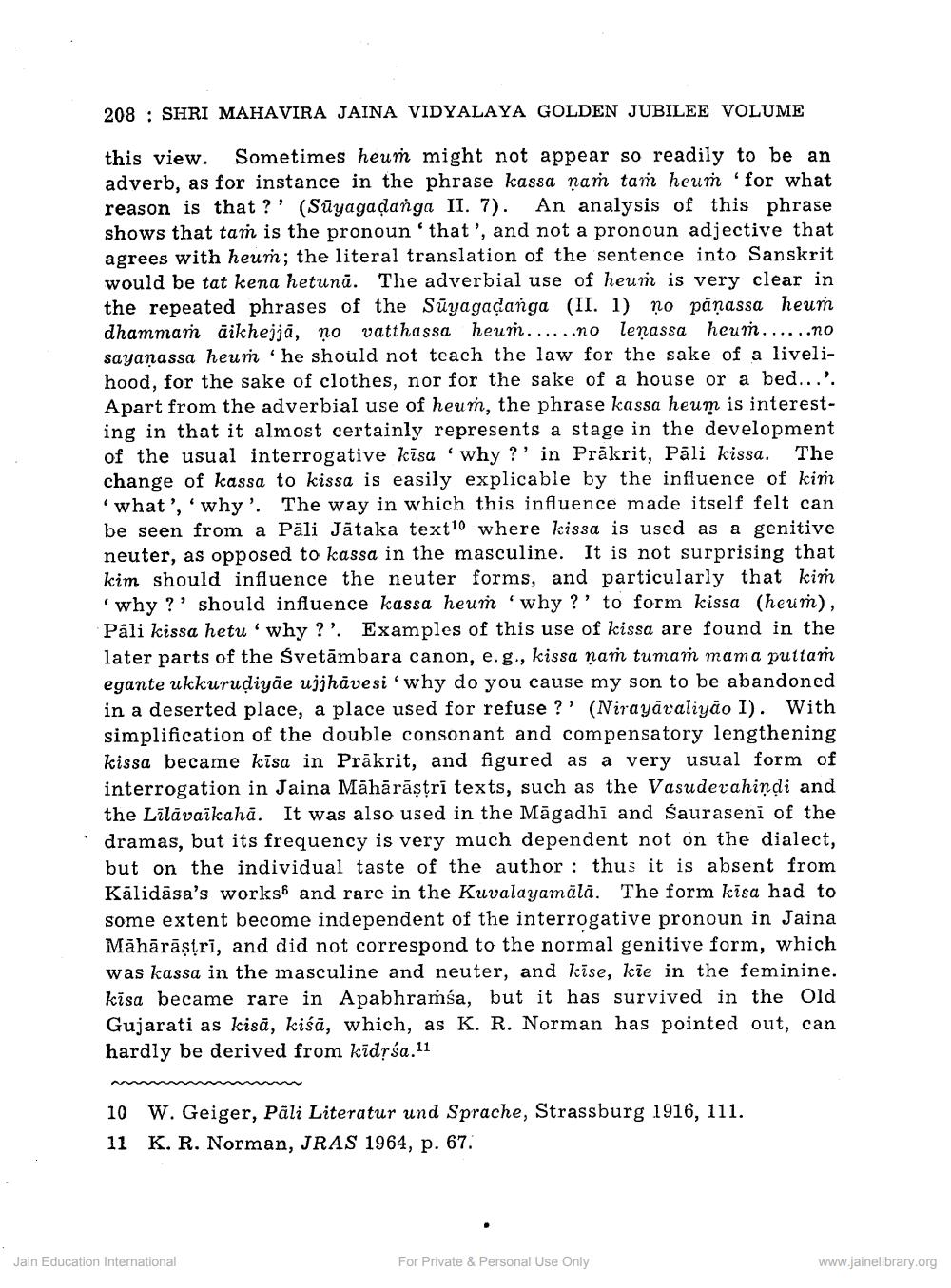Book Title: Some Interrogative Particles in Prakrit Author(s): L A Schwarzshield Publisher: Z_Mahavir_Jain_Vidyalay_Suvarna_Mahotsav_Granth_Part_1_012002.pdf and Mahavir_Jain_Vidyalay_Suvarna_ View full book textPage 5
________________ 208 SHRI MAHAVIRA JAINA VIDYALAYA GOLDEN JUBILEE VOLUME : this view. Sometimes heum might not appear so readily to be an adverb, as for instance in the phrase kassa nam tam heum 'for what reason is that?' (Suyagadanga II. 7). An analysis of this phrase shows that tam is the pronoun that', and not a pronoun adjective that agrees with heum; the literal translation of the sentence into Sanskrit would be tat kena hetuna. The adverbial use of heum is very clear in the repeated phrases of the Suyagadanga (II. 1) no panassa heum dhammam äikhejjā, no vatthassa heum......no lenassa heum......no sayanassa heum he should not teach the law for the sake of a livelihood, for the sake of clothes, nor for the sake of a house or a bed...'. Apart from the adverbial use of heum, the phrase kassa heum is interesting in that it almost certainly represents a stage in the development of the usual interrogative kisa why?' in Prikrit, Pali kissa. The change of kassa to kissa is easily explicable by the influence of kim 'what', 'why'. The way in which this influence made itself felt can be seen from a Päli Jātaka text10 where kissa is used as a genitive neuter, as opposed to kassa in the masculine. It is not surprising that kim should influence the neuter forms, and particularly that kim 'why?' should influence kassa heum why?' to form kissa (heur), Påli kissa hetu why?'. Examples of this use of kissa are found in the later parts of the Svetämbara canon, e. g., kissa nam tumaṁ mama puttaṁ egante ukkurudiyde ujjhävesi 'why do you cause my son to be abandoned. in a deserted place, a place used for refuse?' (Nirayavaliyão I). With simplification of the double consonant and compensatory lengthening kissa became kisa in Prakrit, and figured as a very usual form of interrogation in Jaina Mähäräştri texts, such as the Vasudevahindi and the Lilävaikaha. It was also used in the Magadhi and Sauraseni of the dramas, but its frequency is very much dependent not on the dialect, but on the individual taste of the author: thus it is absent from Kalidasa's works and rare in the Kuvalayamälä. The form kisa had to some extent become independent of the interrogative pronoun in Jaina Mahārāștri, and did not correspond to the normal genitive form, which. was kassa in the masculine and neuter, and leise, kie in the feminine. kisa became rare in Apabhramsa, but it has survived in the Old. Gujarati as kisd, kiád, which, as K. R. Norman has pointed out, can. hardly be derived from kidṛśa.11 10 W. Geiger, Päli Literatur und Sprache, Strassburg 1916, 111. 11 K. R. Norman, JRAS 1964, p. 67. Jain Education International For Private & Personal Use Only www.jainelibrary.orgPage Navigation
1 ... 3 4 5 6
